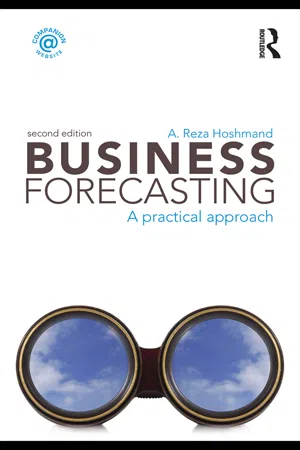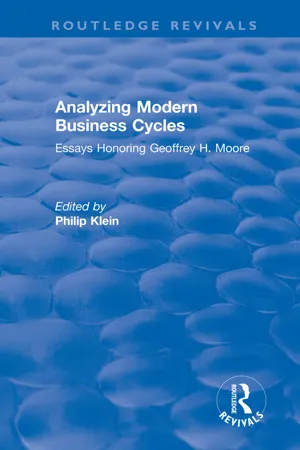Business Cycle
The business cycle refers to the recurring pattern of expansion and contraction in an economy. It typically consists of four phases: expansion, peak, contraction, and trough. During an expansion, the economy grows, reaching a peak before entering a contraction phase, which leads to a trough. This cyclical pattern reflects the fluctuations in economic activity over time.
6 Key excerpts on "Business Cycle"
- eBook - ePub
Economics for Investment Decision Makers
Micro, Macro, and International Economics
- Christopher D. Piros, Jerald E. Pinto(Authors)
- 2013(Publication Date)
- Wiley(Publisher)
...Second, a cycle has an expected sequence of phases representing alternation between expansion and contraction. Third, such phases occur at about the same time throughout the economy—that is, not just in agriculture or not just in tourism but in almost all sectors. Fourth, cycles are recurrent (i.e., they happen again and again over time) but not periodic (i.e., they do not all have the exact same intensity and duration). Finally, cycles typically last between one and 12 years. Although Burns and Mitchell’s definition may appear obvious in part, it indeed remains helpful even more than 60 years after it was written. Many investors like to think that there are simple regularities that occur at exactly the same time, every year or cycle: for example, shares always rally in January and big crashes occur in October. Of course, things are much more complex. The truth, as Burns and Mitchell remind us, is that history never repeats itself exactly, but it certainly has similarities that can be taken into account when analyzing the present and forecasting the future. 2.1. Phases of the Business Cycle A Business Cycle consists of four phases: trough, expansion, peak, contraction. The period of expansion occurs after the trough (lowest point) of a Business Cycle and before its peak (highest point), and contraction is the period after the peak and before the trough. 1 During the expansion phase, aggregate economic activity is increasing (aggregate is used because some individual economic sectors may not be growing). The contraction—often called a recession, but may be called a depression when exceptionally severe—is a period in which aggregate economic activity is declining (although some individual sectors may be growing)...
- eBook - ePub
Contemporary Economics
An Applications Approach
- Robert Carbaugh(Author)
- 2016(Publication Date)
- Routledge(Publisher)
...Then national output declines, profits and real incomes decrease, and the unemployment rate increases to uncomfortably high levels as many workers lose their jobs. Eventually, the economic contraction vanishes and recovery begins. The recovery may be slow or fast. It may be partial, or it may be so strong that it results in a new era of prosperity. Or it may be characterized by escalating inflation, soon to be followed by another downturn. The upward and downward movements in output, employment, and inflation form the Business Cycle that characterizes all market economies. Phases of the Business Cycle The term Business Cycle refers to recurrent ups and downs in the level of economic activity over several years. Although Business Cycles may vary in intensity and duration, we can divide each into four phases, as shown in Figure 11.2. Peak. At the peak of a Business Cycle, real GDP is at its highest point. Employment and profits are usually strong. Recession. A recession is a period of significant decline in total output, income, employment, and trade, that usually lasts from 6 months to a year and is marked by widespread contraction in many sectors in the economy. A recession begins at a peak and ends at a trough. For example, the U.S. economy began the Great Recession in December 2007, which lasted until June 2009. A typical recession boosts the unemployment rate up more than three percentage points. Even small recessions increase the unemployment rate more than two points. Trough. The low point of real GDP, just before it begins to turn upward, is called the trough of a Business Cycle. At the trough, unemployment and idle productive capacity are at their highest levels relative to the previous recession. The trough may be short-lived or quite long. Recovery. Recovery is an upturn in the Business Cycle during which real GDP rises...
- eBook - ePub
Business Forecasting
A Practical Approach
- A. Reza Hoshmand(Author)
- 2009(Publication Date)
- Routledge(Publisher)
...3 The Macroeconomy and Business Forecasts Nations seek economic growth, full employment, and price-level stability as their major macroeconomic goals. Business decisions are made in the context of the macroeconomy of a nation. Firms take their cues from the economic environment in which they operate. When favorable macroeconomic conditions prevail, businesses expand operation and output. Contractions in the economy generally lead to slower growth patterns. Long-run economic growth has not always been steady as factors such as inflation, unemployment, recession, and depression have impacted it negatively. As was pointed out in Chapter 2, long-term trends, seasonal variations, cyclical movements, and irregular factors combine to generate widely divergent paths for businesses in an economy. Given these conditions, how are businesses to predict future growth and contractions in the economy? In this chapter we will discuss specifically those cyclical linkages that bind the economy together during a typical Business Cycle, and how our knowledge of these linkages help us in making good forecasts at the industry and firm level. 3.1 Phases of the Business Cycle Economists use the term “Business Cycle” when they observe alternating increases and decreases in the level of economic activity, sometimes extending over several years. The duration and intensity of the cycle vary from cycle to cycle. Yet all Business Cycles display common phases, which are variously labeled by economists. A Business Cycle generally follows the four phases of peak, recession, trough, and recovery. Peak refers to the economic condition at which business activity has reached a temporary maximum and shows the onset of a recession or upper turning point. During this phase the economy is at full employment and the level of real output is at, or very close to, its capacity. It is expected that the price level will rise during this phase of the Business Cycle. Recession follows a peak in the economy...
- eBook - ePub
Analysing Modern Business Cycles
Essays Honoring Geoffrey H.Moore
- Philip A. Klein(Author)
- 2019(Publication Date)
- Routledge(Publisher)
...Classical cycles historically have been the main concern of Business Cycle studies at the National Bureau of Economic Research (NBER) in New York. The NBER studies began with the work of Mitchell (1927; see Moore and Zarnowitz 1986). The classical cycle fits the Business Cycle theories of Kalecki (1939) and Schumpeter (1939). It also fits the hints Keynes (1936) offered about the nature of Business Cycles; and it is the cycle that is clearly at the heart of the post-Keynesian models of, for instance, Kaldor (1940) and Hicks (1950). Table 3.1 shows that there was no classical contraction in the United States between February 1961 and December 1969, a period of 106 months; Table 3.2 shows a classical upswing continuing in Australia from September 1961 to July 1974, a period of 154 months. The experience of the 1960s, especially in the United States with no classical downturn between 1961 to 1969, contributed to a revival of interest in growth cycles. 4 Growth cycles are defined as fluctuations in the rate of growth of aggregate economic activity, with periods when the growth rate is above the long-term trend rate alternating with periods when it is below this long-term value, but not necessarily negative. This enables account to be taken of the important fact that a slowdown may occur when the growth rate, though continuing positive, is slower than the long-term trend rate of growth. Hence excess capacity, notably unemployment, rises. On the other hand, during the expansion phase of the growth cycle, when excess capacity is being absorbed, the actual rate of growth is above the long-term trend rate of growth. Table 3.1 Phases of Business Cycles, U.S., 1948–87 Sources: a CIBCR 1988a. b U.S. Department of Commerce 1988, p...
- eBook - ePub
Analyzing Modern Business Cycles
Essays Honoring
- Philip Klein(Author)
- 2017(Publication Date)
- Routledge(Publisher)
...Classical cycles historically have been the main concern of Business Cycle studies at the National Bureau of Economic Research (NBER) in New York. The NBER studies began with the work of Mitchell (1927; see Moore and Zarnowitz 1986). The classical cycle fits the Business Cycle theories of Kalecki (1939) and Schumpeter (1939). It also fits the hints Keynes (1936) offered about the nature of Business Cycles; and it is the cycle that is clearly at the heart of the post-Keynesian models of, for instance, Kaldor (1940) and Hicks (1950). Table 3.1 shows that there was no classical contraction in the United States between February 1961 and December 1969, a period of 106 months; Table 3.2 shows a classical upswing continuing in Australia from September 1961 to July 1974, a period of 154 months. The experience of the 1960s, especially in the United States with no classical downturn between 1961 to 1969, contributed to a revival of interest in growth cycles. 4 Growth cycles are defined as fluctuations in the rate of growth of aggregate economic activity, with periods when the growth rate is above the long Table 3.1 Phases of Business Cycles, U.S., 1948-87 Table 3.2 Phases of Business Cycles, Australia, 1950-87 term trend rate alternating with periods when it is below this long-term value, but not necessarily negative. This enables account to be taken of the important fact that a slowdown may occur when the growth rate, though continuing positive, is slower than the long-term trend rate of growth. Hence excess capacity, notably unemployment, rises...
- eBook - ePub
Essays
On Entrepreneurs, Innovations, Business Cycles and the Evolution of Capitalism
- Joseph A. Schumpeter(Author)
- 2017(Publication Date)
- Routledge(Publisher)
...We may, then, speak either of an equilibrium of growth or — as we prefer — of an equilibrium which, though continually disturbed by growth, continually tends to be re-established. There is nothing in this which, by itself, could produce the Business Cycle. Professor Pigou lends the weight of his authority to this proposition, by word as well as tacendo. And indeed theories looking for an explanation of the cycle in the increase either of population or of capital seem to me hardly worth discussing. (3) I always thought, and still think, that in order to find out whether or not cycles are a phenomenon sui generis, clearly standing out as such from the rest of industrial fluctuations and arising from within the economic system, we ought, in the first instance, to assume the absence of outside disturbances — non-economic ones, or economic ones which cannot be produced or avoided by economic action, both of which we are going to call “casual” — acting on the system...





